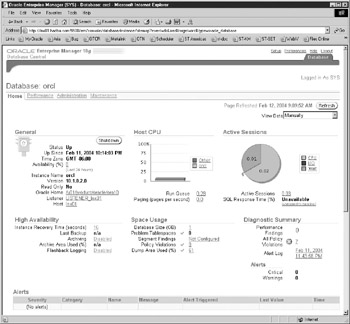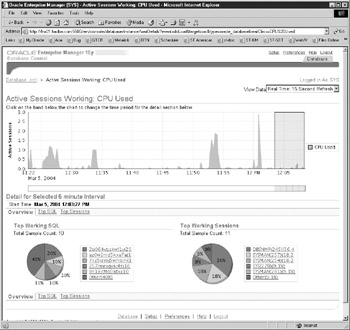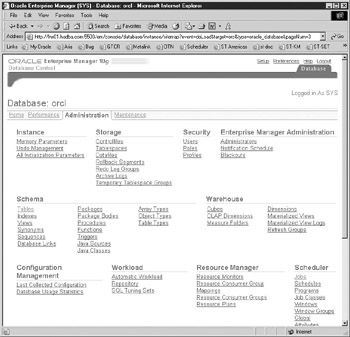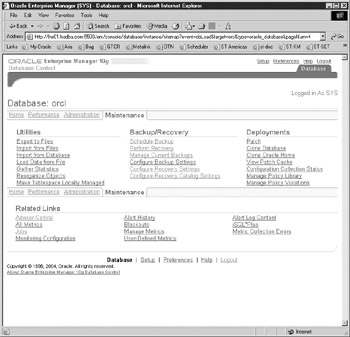Enterprise Manager
|
| < Day Day Up > |
|
Before we go any further, we need to talk about Oracle's GUI interface for the database: Oracle Enterprise Manager (EM). Enterprise Manager has been around for a long time, and if you are like most DBAs in the world, you have steadfastly avoided it as though it carried disease-which it may have at some time; the reports vary. EM has always set out to be an interface built to simplify the overwhelming duties of the DBA by consolidating all database management into a single suite of utilities that could be configured to monitor the entire enterprise. As such, EM has made some excellent selling points for itself. If you manage 100 or more databases, chances are you use EM as a point of necessity. And the visual look at database information was always a blessed reprieve from V$VIEW hunting.
But, alas, EM was always hampered by a bulky, three-tier implementation. While effective for the large-enterprise user, this stood in the way of wide adoption among the experimenting and tinkering crowd, or anyone without massive free resources. In addition to having a huge footprint, EM never matched up well against third-party add-on products that had slick interfaces and fast (read: C instead of Java) loads.
We're here to tell you, though, that EM has turned the proverbial corner. The latest version, now written almost entirely in HTML, is fast, effective, and light-footed. It's not going to win any design awards, but EM now gets the job done with little preconfiguration. And EM now leverages the built-in functionality of the Oracle RDBMS in ways that make it requisite instead of optional.
If you are wary, we understand. EM has been hampered by problems in the past, when hours could quickly disappear as you attempted to get it up and running. But it's simply too good to pass up in Oracle Database 10g. So much so that we are basing most of our exercises in this book on Enterprise Manager interfacing. The bottom line is that the new functionality of Oracle Database 10g is simple and straightforward when you use EM; when you hit everything at the command line, you are usually just reinventing the wheel, or worse, missing out on some of the best reasons to upgrade.
Oracle Database Control
The easy-to-use, light-footed version of Enterprise Manager is now referred to as Oracle Database Control. This is to differentiate the database console from the three-tier, 400-pound gorilla known as Oracle Grid Control (discussed next). Database Control comes standard when you install Enterprise Edition, and if you use the Database Configuration Assistant, it is set up without any trouble. By default, with the first database created, you can immediately connect via your web browser to Database Control on port 5500:
http://lnx02.hadba.com:5500/em/console
After you do this, you need to log in as the sys user as sysdba, and then you have access to the Database Control console. The entire suite of control features now exists as HMTL, which may not be as pretty as the Java app version, but makes it far more effective for connecting remotely from other systems, as it can all be handled from within a web browser.
Database Control Console: Navigation
EM is divided into four pages: Home, Performance, Administration, and Maintenance- accounting for the primary uses for the GUI.
EM Home
The home page provides general information, such as the database status, host name, and listener. As shown in Figure 2-1, it gives a quick look at the CPU utilization and the active sessions, and then, by default, provides the latest Automatic Database Diagnostic Monitor (ADDM) advice and standard system alerts.

Figure 2-1: EM Database Control home page
Performance
The Performance page provides generalized performance indicators for the instance to which you are connected. It provides a look at host resources, instance service time, and instance throughput. For a closer look at current top usage sessions, for instance, you could click on the box for CPU Used in the Instance Service Time graph. This will load a Top Sessions chart that you can then review, as shown in Figure 2-2.

Figure 2-2: Top Sessions from the Performance page
The performance charts default to running a check every 15 seconds, but this can be altered from the View Data drop-down list in the upper-right corner of the page.
Administration
The Administration page is divided into sections that represent the different areas of administration that are typical of the DBA: schema, storage, security, and instance (see Figure 2-3). Here is where you can work with the Resource Manager and Scheduler, as well as materialized views (under Summary Management).

Figure 2-3: The Administration page
Maintenance
The Maintenance page provides access to three groupings of functions: utilities, backup/recovery, and software management. The utilities section provides access to export, import, and SQL*Loader; it also allows you to use the SQL Access Advisor (we talk about this in the section 'Materialized Views') and also to reorganize objects. (See 'Online Reorganization' later in the chapter.) The backup/recovery is discussed in Chapter 9. Finally, the software management allows you to review patching and upgrade information for the instance. See Figure 2-4 for an example of the Maintenance page.

Figure 2-4: The Maintenance page
Oracle Enterprise Manager Grid Control
The Grid Control EM is the fully loaded Enterprise Manager behemoth we have come to love/hate. Grid Control provides a singular interface for managing multiple databases across an enterprise, where Database Control is for control of an individual database. In addition, Grid Control extends EM functionality out past the database, to include application server and node management. Grid Control requires a central repository (think Oracle Management Server, from previous EM releases) to operate, and installs and requires the kind of management duties that were common in the base EM release in 9i. EM Grid Control is a separate installation from the database, requires a repository database, has an enormous memory footprint, and (you guessed it) is separately priced and licensed. Grid Control is aimed squarely at users who need a consolidation client for monitoring and managing a large number of databases, application servers, and web servers. If you are not that person, EM Grid Control may not be necessary for you.
Oracle Grid Control in this Book
In this book, most of the EM functionality we discuss comes by way of the EM you get by default with any Oracle Database 10g Enterprise Edition installation, and by connecting to the host name 5500/em. However, EM Grid Control is required if you want to use the GUI for Real Application Clusters (RAC) management and Data Guard (DG) management. This is due to the fact that RAC and DG require access to more than a single instance of a database, and must consolidate information about systems across an enterprise. Thus, an enterprise utility is required.
For installation and configuration tips on EM Grid Control, your first stop should be Oracle Enterprise Manager Grid Control Installation and Basic Configuration 10g Release 1 (10.1), from the online documentation set. See the bibliography for more information. The installation and configuration specifics are beyond the scope of this book.
EM and Availability
Sometimes, one of the biggest snags in availability is our own scrambling to get a full picture of the situation, or our attempt to get at a functionality that requires a significant amount of SQL or PL/SQL coding. The bottom line is that EM allows an easy and manageable way to use new Oracle Database 10g functionality without getting lost in the step-by-step details. Granted, a knowledge of the details will always prove to be important. But with a utility such as EM, you can choose what details matter to you, and leave the rest to the GUI interface.
|
| < Day Day Up > |
|
EAN: N/A
Pages: 134